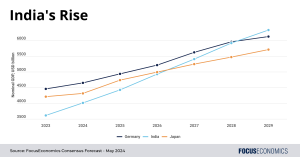
Three key insights from our long-term Consensus Forecasts
FocusEconomics
The world economy has been in constant flux in recent decades, and the next ten years promise to be no different. In our latest special report, we look at three key takeaways from our long-term Consensus Forecasts for the next decade. Below is a summary of what to expect:
U.S. and Europe will continue to diverge
Our long-term Consensus Forecasts expect U.S. real GDP growth to outpace Euro area real GDP growth by an average of 0.6 percentage points per year over the next decade. As a result, the U.S. economy should be over 16 trillion dollars larger than the Euro area economy by 2034, compared to 12 trillion dollars today. Stronger demographics, a laxer regulatory environment, a more flexible labor market, a more unified capital market and leadership in emerging technologies will all be important factors helping the U.S. economy forge ahead of the European economy in the coming years.
China’s economic growth will slow sharply
China’s annual GDP growth is to slip below 3% within a decade’s time, according to our long-term Consensus Forecasts—above the rates of developed markets but a far cry from the growth seen in China in recent decades. A host of factors will be behind this slowdown. The scope for relatively easy catch-up growth is diminishing as the physical capital stock and urbanization rate rise. The population will decline at an ever-sharper pace in the coming years, weighing on private consumption and the property sector. And intensifying trade and tech restrictions from the West will hamper the export sector and investment.
India to become the world’s third-largest economy
Our long-term Consensus Forecasts project that India will become the world’s third-largest economy in nominal GDP terms before the end of this decade, with economic growth expected to average over 5% per year. This impressive economic performance will be underpinned by multiple drivers, chiefly a population expected to grow in excess of 10 million people per year, business-friendly reforms, political stability under long-serving Prime Minister Narendra Modi, and the country’s attractiveness as a base for firms looking to divest from China. That said, China was growing at over 8% per year when it had a similar GDP per capita to India; as such, India is still not maximizing its full economic potential. The full article is available here. This article was published at FocusEconomics.
Comments are closed for this article!